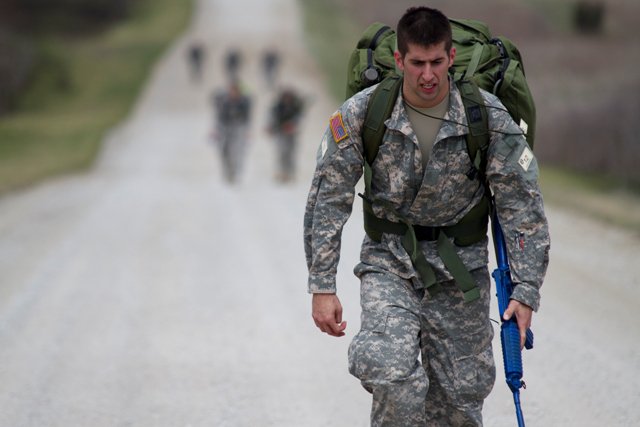We’ve been revisiting some of the posts we’ve made earlier and are getting out and doing refresher exercises, getting some land navigation and other tasks in. This one will deal with everyone is SF’s favorite pastime … rucking.
Everyone has their own tips of the trade and the vast majority of them are good. The main thing is that you have to find what works best for you. What I’m doing here is just giving you the benefits of my own experiences and hopefully, they’ll work for you. They did for me.
I recently got an email from Sean T. who asked a good question about rucksack marching and specifically in how the load was packed. He wrote, “I’ve read numerous articles about how the load of your rucksack should be distributed over your hips. I’m having issue [sic] with rubbing on my hips and low back pain. Is it because I’ve packed the weight too low?”
I take it from Sean’s message that he took the “distribute the weight over the hips” bit to mean that he was packing his load down low. No, and it is a common mistake among beginners and people carrying heavy rucks for the first time.
Your weight should be packed up high between the shoulder blades. If your ruck has radio pouch up high, that is where the sandbag or weight plates belongs. I prefer sandbags because it will mold to your pack and back and doesn’t have any sharp edges that can rub you on a ruck.
The guys over at GoRUCK sell some nice molded plates that will do the trick and they take all the guess work out of it. But like I said, I prefer the sand routine but use whatever works for you. In the video below, I have a 45-pound bag in my small ruck that I use for short hikes that we take with us.
We covered boots at length in our earlier article. I have several broken in pairs that I take on hikes depending upon the conditions. For the purposes of this exercise, I wore my heavier duty Merrell Sawtooth boots. We had a bunch of rain that dropped over an inch overnight and it was still misting out there on the day we did the video. Later we got another inch plus. The trail was muddy, very deep in places and the Sawtooth’s deeper tread pattern was probably a bit better for that day.
Water and staying hydrated is very important even on a day where it is a bit raw out and is raining on you. You’ll still sweat and dehydration is a killer. On this particular day, although it was raining a bit, we still drank constantly, keeping the hydration level up.
The trail we used is a closed loop so it was up-down with very little flat terrain involved. When rucking it is best to lean forward and getting the arm swing going from side to side rather than a typical running type swing back and forth.
When it comes to increasing speed, I don’t recommend that you run with a rucksack on your back while in training. They’ll be times in your selection course or the qualification course that you’ll have to make up time or want to pick your pace, especially on the downhill slopes. At those times, you’re going to have to do what you must, but for training purposes don’t do it. Learn to increase your speed without running. Running with a ruck will hurt your knees and back…take it from the guy with two arthritic knees.
I like to lengthen my stride on the downhill slopes, some guys will tell you the exact opposite. Again, find out what works for you and stick to it. But the bottom line is, don’t resort to running to increase your speed. You’re going to have to learn to ruck quickly without running sooner or later, and there’s no time like the present.
Already have an account? Sign In
Two ways to continue to read this article.
Subscribe
$1.99
every 4 weeks
- Unlimited access to all articles
- Support independent journalism
- Ad-free reading experience
Subscribe Now
Recurring Monthly. Cancel Anytime.
The standard is a 15-minute mile pace to pass the courses, you should be aiming to go lower than that. We were keeping a 14:30 pace on our practical exercise video, which means we’ll have to step it up as well. Back in the day, I used to maintain a 13-minute per mile pace which would bring myself in with around 20-25 minutes to spare on a 12-miler.
On one certification 20-miler at Ft. Bragg, our team maintained a 13-minute mile pace for the entire length of the course and that was with two 7-8 minute breaks built in to change socks and catch a breather. Of course, since the movement wasn’t considered tactical and was mapped out along a road, our communications supervisor strapped a boom box atop his rucksack and we rocked to AC-DC and Metallica. Much better than the sound of boots scuffling for 20 miles. We ended up with the best time in the battalion that night…the staff when learning of the music…were not amused. Always look for an edge, right?
If anyone else has any questions, feel free to send them along to
[email protected] and I’ll be glad to answer them and we may use it in our next video.
Photo courtesy of US Army
This article is courtesy of SpecialOperations.com









